Have you ever wondered, “What does lotus root taste like?”
Lotus roots (also known as lotus stems) are mild in flavor and taste like a starchy potato. However, it’s that extra crispy addictive texture sets it apart from ALL other vegetables. Our Sichuan Spicy Lotus Root Stir Fry is crunchy, garlicky, savory, spicy and takes less than 20 minutes to prepare. It’s a quick and easy vegan Asian dish for a weekday dinner.
Stir-fried lotus root is also commonly eaten during the Chinese New Year celebration because it symbolizes abundance and prosperity. The Cantonese word for lotus root is “Leen Ngau” which sounds like “having year after year” so it is lucky to eat in the Lunar New Year.

Jump to:
What is a Lotus Plant?
We can’t wait for you to try this unique aquatic rhizome plant called the lotus. The root of the plant thrives underwater producing huge leaves and flowers that grow upward and display on top of the water. Of course, the budding flowers are gorgeous and magical but just wait until you explore the wonderful textures and taste of this interesting vegetable.
Edible Parts
Did you know that you can eat every part of the lotus plant?
Yes, you can! You can even eat the lotus seeds. They add a pop of crunch in a Lucky Shrimp and Lotus Seeds stir fry or can be made into lotus paste for mooncakes. Even, the flowers can be steeped as a tea.
The edible stem is what we are using today to make a stir-fried side dish. Lotus root is called Lián’ǒu (莲藕) in Chinese and renkon (れんこん) in Japanese. Chinese, Japanese, Korean and many other nationalities use this special crunchy vegetable to make delicious soups, stir fries, pickles, salads, braised or made into lotus chips. The actual root is not that glamorous to look at. It’s usually tan or beige with little sprouts at the end. However, once peeled, it has snow white flesh with holes in the core.
One of its best attributes is its ability to take on the flavors and seasonings of whatever you add to it. Lotus root recipes can be either savory like our Spicy Beef and Longevity Noodles or sweet like Braised Orange Anise Lotus Root.
Ingredients
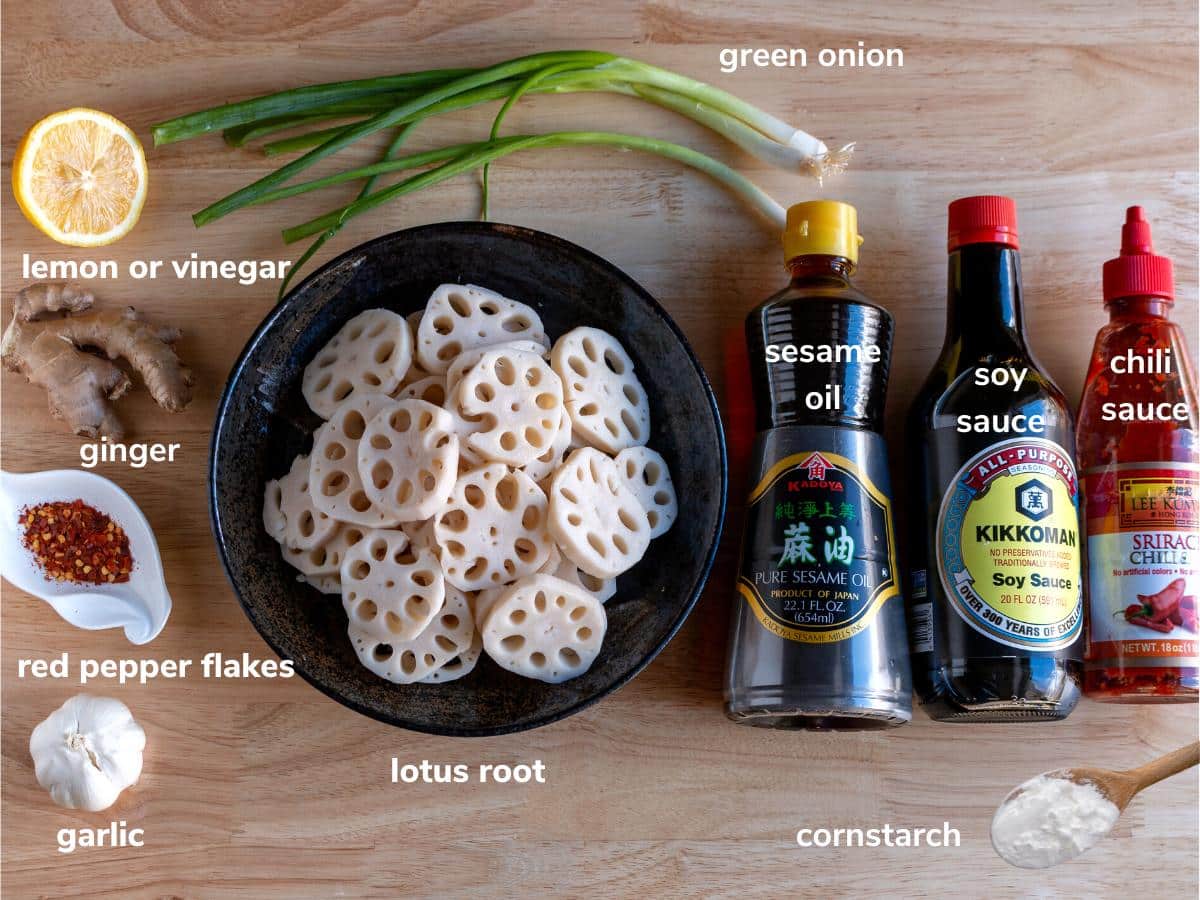
Lotus Root –It’s the main ingredient in our spicy lotus root stir fry. You can buy them fresh with the peel still on, peeled and sliced in the refrigerator section, or frozen at Asian Markets near you. In addition, you can also find them canned but these are not as crisp.
Lemon water or vinegar – When the root is peeled and exposed to air, it can oxidize and start to turn brown. Either lemon or vinegar water can prevent this from happening. If you purchase them refrigerated or frozen, they are commonly preserved with a citric acid solution to prevent oxidation. We still like to blanch the lotus roots in either lemon or vinegar to prevent any further color changes during the cooking process. The vinegar or lemon juice soak also removes the slight bitterness of the root.
Ginger – fresh is best but substitute with 1 to 1.25 teaspoons of dried ground ginger for a large 1-inch knob of fresh ginger.
Garlic – but of course! Garlicky is one of our favorite food descriptions. Adjust to your liking.
Chili paste or Sriracha Sauce – Adds that kick of spice. If you have a full Asian pantry, doubanjiang sauce used in our Mapo Tofu is very delicious in stir fried lotus root.
Soy sauce – to taste. Use tamari sauce to keep this recipe gluten free.
Sesame Oil – for that umami flavor
Dried Red Pepper Flakes – easy to find ingredient that adds another layer of Sichuan spiciness.
Cornstarch + Water – slurry to thicken the sauce.
Green Onions – aromatic and a delicious garnish.
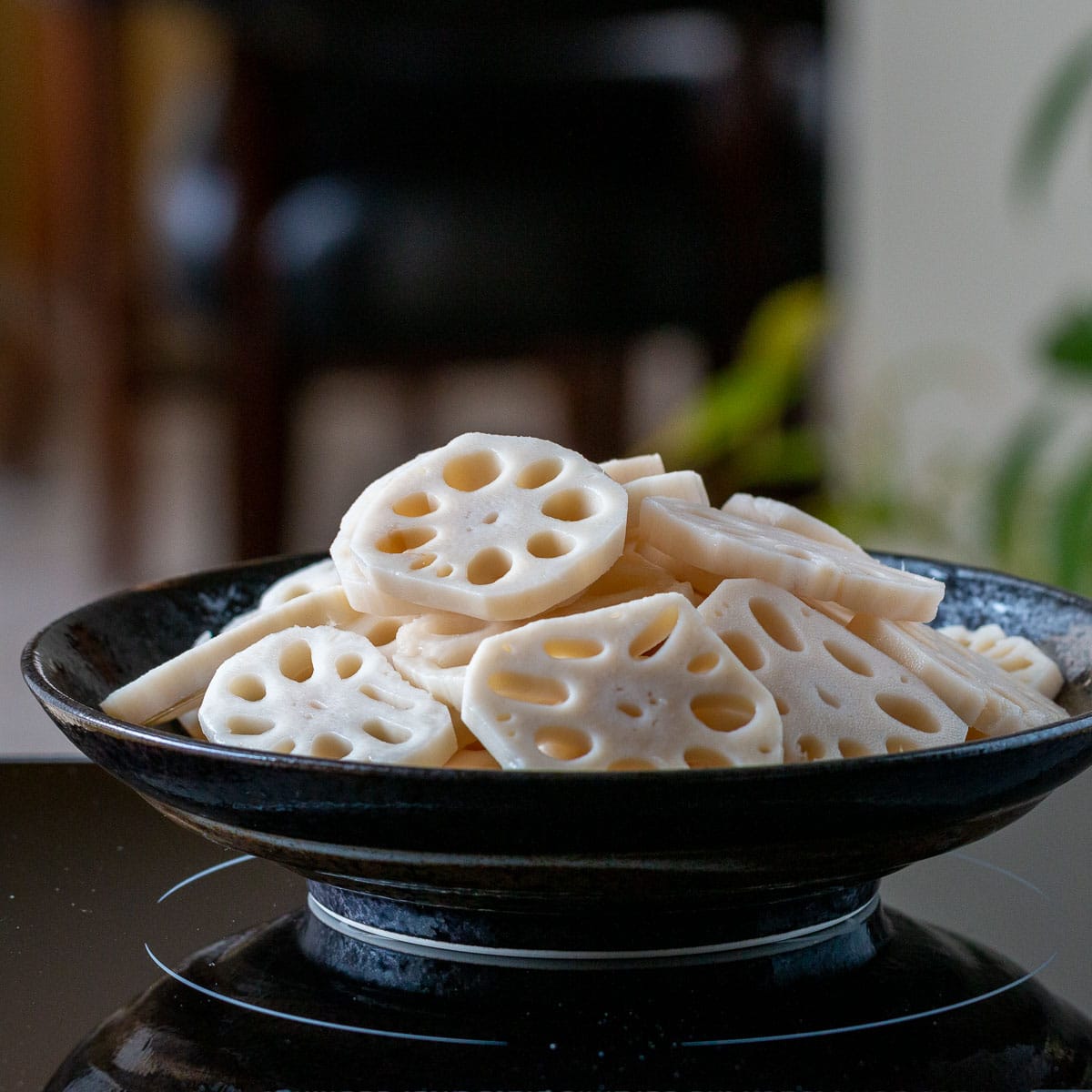
Substitutions
There is no perfect substitute for lotus root. However, in a pinch you could use jicama, daikon radish, turnip, water chestnuts or potatoes. Each of these items will change the taste and texture profile of the Chinese lotus root recipe but are still delicious. In addition, each item may need more or less time to blanch before stir frying.
To keep this recipe gluten-free, exchange the soy sauce with tamari sauce and you are good to go.
Prepping
For the full and complete recipe and video, please scroll down to the recipe card for details.
- Fresh Whole Lotus Root Prep: Cut the ends off the vegetable. Peel, slice thin, and rinse well. As it grow in muddy murky waters, be sure to wash it thoroughly to remove any dirt or debris.
- If using frozen ones, defrost before using. We like to rinse pre-sliced refrigerated or frozen lotus prior to using in a recipe. Canned ones do not need to be washed prior to consuming. In addition, many times the refrigerated lotus roots have already been boiled (blanched) and are soaking in a solution of citric acid. (In this case, it is not required to soak and blanch before using in a stir fry.)
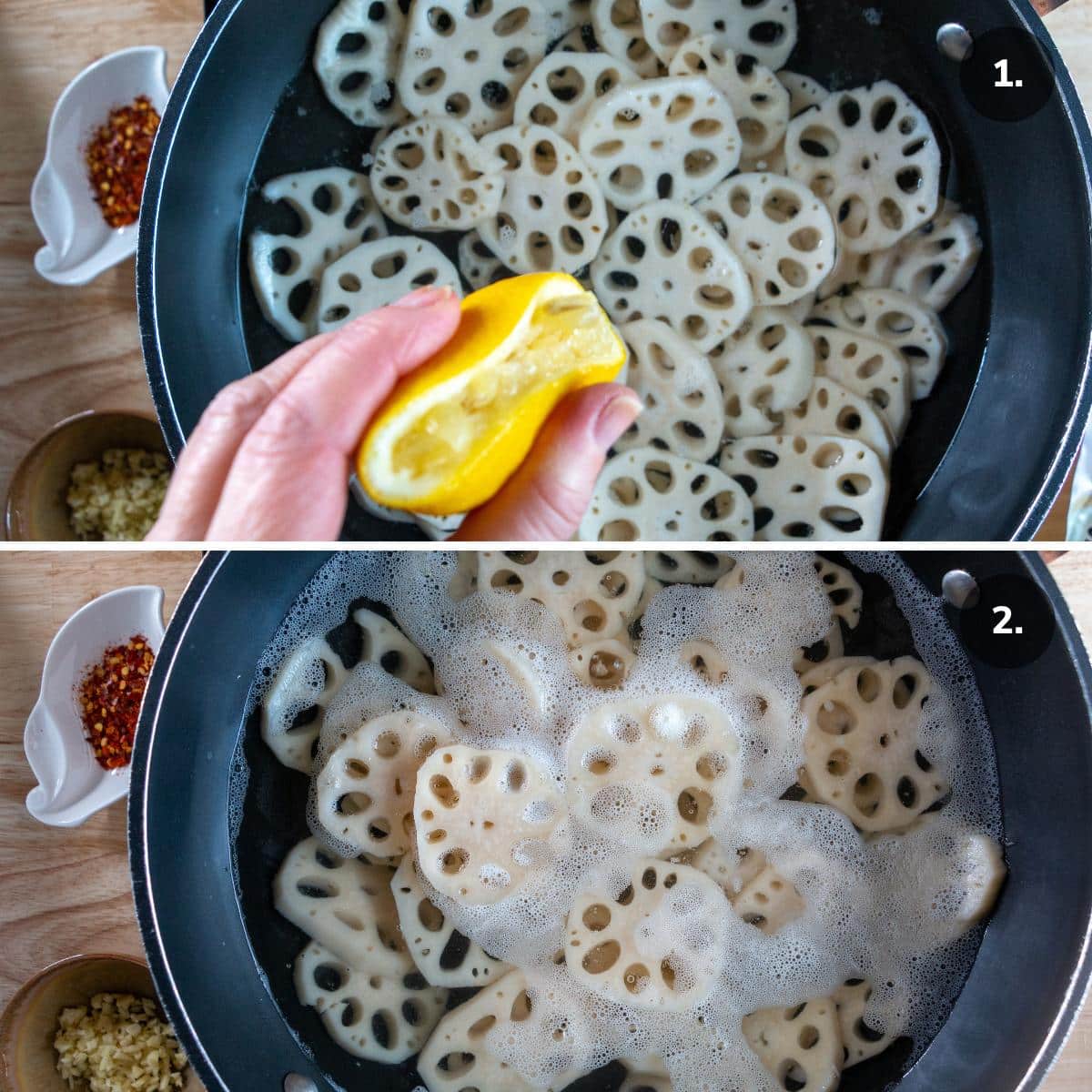
- After you are done rinsing, place raw lotus slices in a large pot of water with either lemon or vinegar and salt to prevent further oxidation and it also helps to remove that slight bitterness.
- Blanch (boil) the slices in the lemon or vinegar water for approximately 2 minutes in lightly boiling water with the lid on. Immediately drain and rinse with cool water to stop the cooking process. Drain well and set aside. At this point, the lotus root is safe to cook and consume in a Spicy Sichuan Hot Pot (or mild broth) or any of your favorite recipes.
Sauce and Aromatics
- Make the stir fry sauce. Mix soy sauce, sesame oil, water, and cornstarch slurry together and set aside.
- In a frying pan or wok, add oil, ginger, chili sauce (Sriracha), garlic, whites of green onion and rinsed and drained blanched lotus root slices.
- Add dried red chili pepper flakes or fresh chilis to desired heat level.
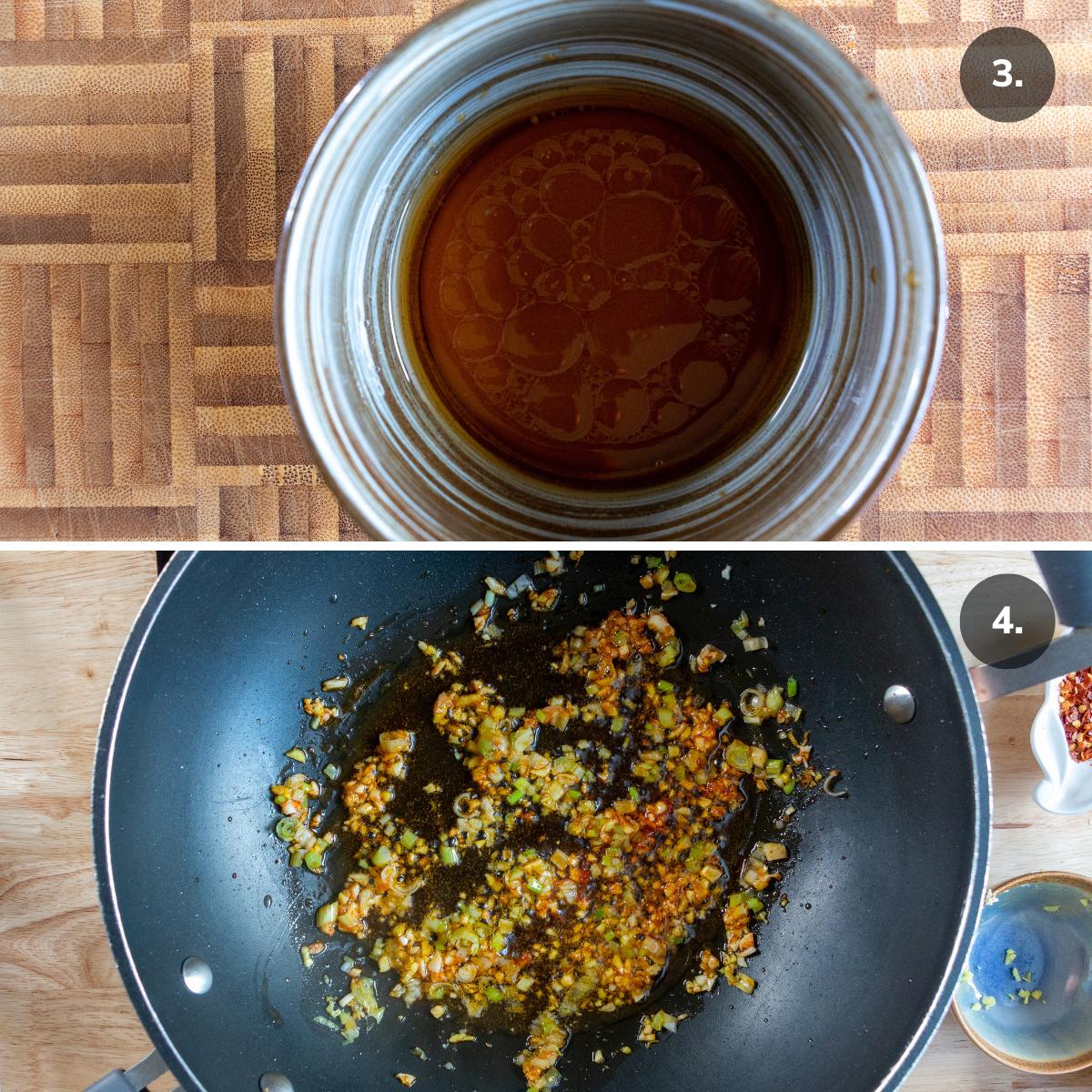
Stir Frying
- Fry for couple of minutes on each side as I love that little sear. If you have a small wok or frying pan, you may want to do this in batching to increase the pan’s capacity for full contact with each lotus root slice.
- Lastly, add the stir fry sauce and keep stirring until the sauce thicken.
- Garnish stir fried lotus root with the green section of the green onions and red chili peppers as desired.

Dishes to Serve With
There are a variety of ways to enjoy blanched and cooled lotus root, such as thinly slicing it and adding it to salads or sushi rolls or grating it and using it as a topping for sandwiches or wraps. You can also slice the root into thin rounds and serve it as a crunchy snack, either on its own or with a dipping sauce.
If you want to serve it as part of a traditional Chinese dinner, try this recipe meal plan.
- Shanghai Wonton Soup or Spicy Garlic Cucumber Refrigerator Pickles
- Beef and Peppers in Black Bean Sauce and plain Jasmine white rice.
- Spicy Lotus Root Stir Fry
- Four Ingredient Okra Stir Fry
- Chinese Pear Dessert Soup for a light ending.
Hosting a dim sum or Chinese New Year Gathering? Have fun with these tasty Chinese dishes along with a side of stir-fried lotus root.
- Asian Steamed Scallops with Garlic Vermicelli
- Air Fryer Spring Rolls (Baked instructions included)
- Tofu Veggie Pancakes
- Homemade Chinese Dumplings
- Hong Kong Style Egg Tarts

How to Choose?
There are a few things you should inspect to make sure your lotus root is fresh, not spoiled, and perfect for stir frying.
A healthy lotus root has these following characteristics.
- The skin is usually beige or light tan and should be free from any wrinkles.
- Look for any mold spots. Do not choose any roots with white, black, brown, or green spots or areas.
- They should be firm to the touch and heavy. If it is soft or feels light it could be rotten or dried out.
- Choose ones that are relatively thin and uniform in size, as this will make them easier to cut into thin slices.
- Lastly, cut into the lotus. If the flesh is yellow or pink, it has probably gone bad. A fresh one will be white inside. If the flesh smells sour, discard it right away as it has spoiled.

How to Store
Fresh Lotus Root is best enjoyed as soon as harvested because they can dry out or spoil. However, they can be stored in the refrigerator wrapped in a towel and in a loose baggie for up 1 to 2 weeks. Do not peel or slice but keep them whole.
If you peel or cut them, they will only last 3 to 4 days in the refrigerator. It is best to wash the lotus root well and soak in a bath of vinegar or lemon water, so they do not oxidize or turn brown.
Refrigerated peeled and sliced store-bought lotus roots are generally boiled (blanched), cooled and placed in a citric acid solution and sealed. They can remain in the refrigerator until the date to use by on the sealed package. Once the package has been opened, please consume within 3 days.
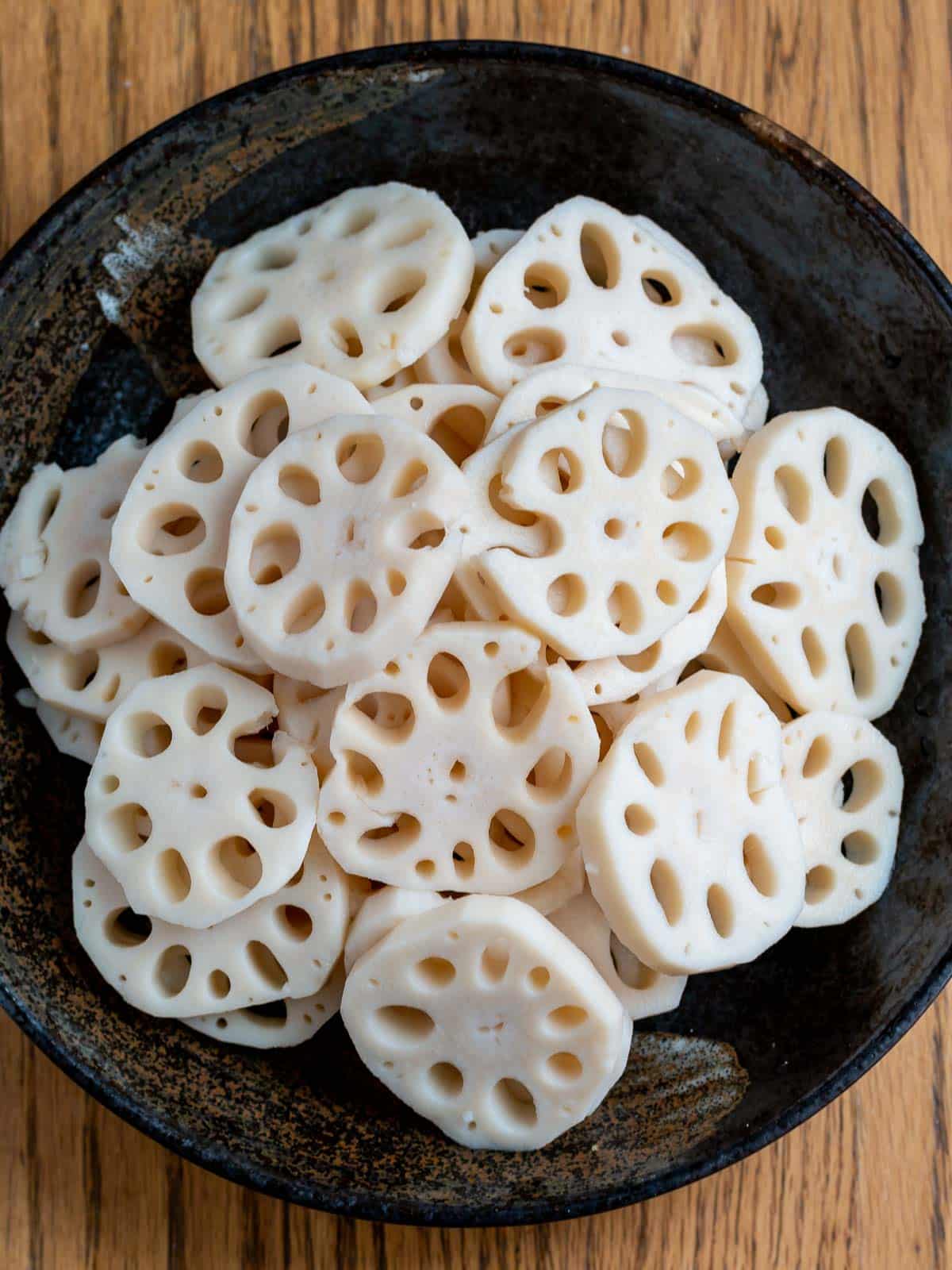
Cooling or Warming Vegetable
In Traditional Chinese Medicine (TCM), lotus root is considered a cool vegetable when raw. However, it should always be at least blanched before eaten. (You can read more about that in our FAQ section below.)
Once the vegetable is blanched, it is considered a neutral food with neither warming nor cooling properties. Cooked lotus root is generally seen as having a balancing effect on the body. It provides strengthening of the spleen, stimulates the appetite, strengthens blood, promotes tissue regeneration, strengthens qi and is also high in fiber.
Frequent Asked Questions (FAQ’s)
You should NOT eat a lotus root raw because there is a higher risk of bacterial infections due to the fact they grow in murky waters. In addition, raw lotus roots can be slightly bitter. Our suggestion is to first wash them thoroughly to remove and dirt and debris. Then, soak them in a lemon or vinegar bath. Finally blanch (boil) lotus roots briefly and then rinse cold water. Then, feel free to use this crunchy vegetable in any recipe you enjoy.
Lotus root is widely available in many Asian and specialty grocery stores. You can also find it in some supermarkets and farmers markets. If you are unable to find it in your local area, you can try ordering it online from an Asian food supplier or through a grocery delivery service.
They are available fresh and whole in the vegetable section of the market. You can also find them prepped, sliced and in a citric acid bath in the refrigerated section or frozen section of markets. Lastly, you may also find them canned.
The cooking time will depend on the method you are using and the size of the slices. Here are some general guidelines for cooking:
1. Boiling for Soup: After prepping, cook over medium high heat in the soup for about 5-10 minutes, or until it is tender.
2. Stir Frying: To fry lotus root, first prep and blanch. Then, fry them for about 2-3 minutes on each side, or until they are golden brown and crispy.
3. Pickling: Combine equal parts vinegar and water, along with some sugar and salt to taste in a small saucepan and boil for about 1 minute. Place roots in a sterilized jar with lid along with any whole aromatics and spices like peppercorns, garlic, chili, etc. Pour the lightly cooled pickling liquid over the lotus roots. Cool completely and refrigerate.
More Chinese New Year Recipes
Did You Like Our Recipe? Leave a ⭐⭐⭐⭐⭐ rating and/or a review in the comments section below. Your feedback is always appreciated! Follow us for more delicious recipes on Pinterest, Instagram, Twitter and Facebook! Don't forget to sign up for our email list for more free recipes.

Spicy Lotus Root Stir Fry
Ingredients
Blanch Lotus Root
- 12 slices Lotus root or about 2 segments washed, peeled and sliced
- water enough to cover the lotus root slices.
- Salt to taste
- ½ Lemon ½ lemon in water or 2 tablespoons of vinegar to prevent oxidation if using fresh lotus root.
Stir Fry Sauce
- 2 tablespoons Soy sauce
or tamari sauce for gluten free - 1 teaspoon Sesame oil (see chef notes for gluten-free options)
- 1 teaspoon sugar or sugar substitute of choice
- ¼ cup Water
- 1 teaspoon cornstarch
Lotus Root Stir Fry
- 1 tablespoon Oil
light flavored (if you do not have a non-stick pan or wok, you may need 2 tablespoons of oil.) - 1 inch Ginger knob peeled and grated
- 3 cloves Garlic
fresh peeled and minced - 1 teaspoon Sriracha or more to taste (doubanjiang sauce is also delicious)
- ½ teaspoon Red pepper chili flakes
or to taste - 2 Spring onions white part in with the aromatics and reserve the green section for garnish.
- blanched lotus root from above
Instructions
Prepare Lotus Root
- If you are using fresh ginger root, pre-pare a bath of lemon water with ½ lemon juice (or vinegar) and enough water to cover the lotus root slices. Set aside. Wash fresh lotus root segments well. Peel and make sure you let the water run through the holes as they grow in mud - wash well. Slice about ⅛ inch thick. Place lotus root in lemon water bath.
- Blanch (boil) lotus root slices in the lemon or vinegar water for approximately 2 minutes in lightly boiling water with the lid on. Immediately drain and rinse well with cool water to stop the cooking process. Drain well and set aside. (If you are using refrigerated prepared peeled, sliced blanched lotus root preserved in a citric acid solution from the grocery store, you can skip this step. However, be sure to rinse well before using in the stir fry.)
Stir Fry Lotus Root
- While your lotus root is blanching, make the stir fry sauce. Mix soy sauce, sesame oil, sugar or sugar alternatives, water, and cornstarch slurry together and set aside.
- In a frying pan or wok, add oil, ginger, Sriracha sauce, garlic, whites of green onion and rinsed and drained blanched lotus root slices.
- Add dried red chili pepper flakes or fresh chilis to desired heat level.
- Fry lotus root on medium high heat for 2 to 3 minutes on each side to get that nice little sear. If you have a small wok or frying pan, you may want to do this in batches to increase the pan’s capacity for full contact with each lotus root slice.
- Lastly, add the stir fry sauce and keep stirring until the sauce thickens.
- Garnish stir fried lotus root with the green section of the green onions and red chili peppers as desired. Enjoy!




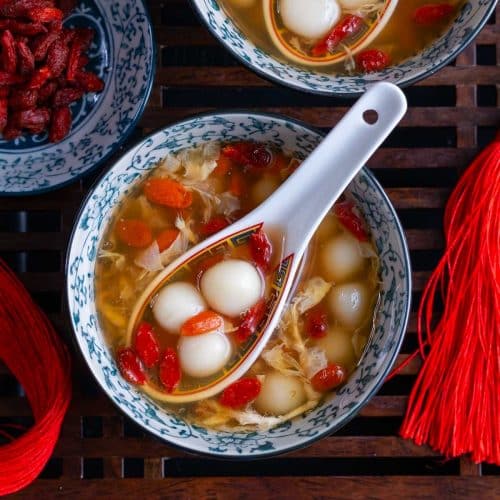


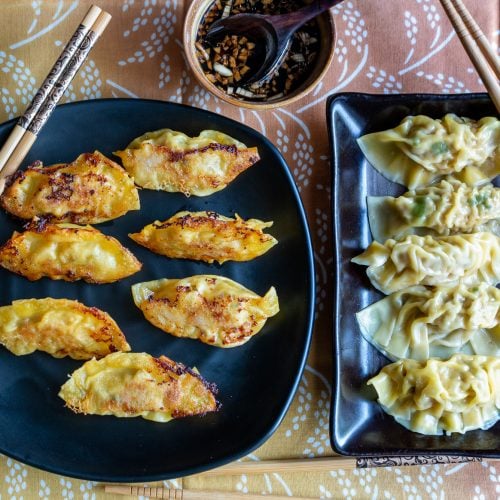





Michelle says
Such a delicious spin on a traditional ingredient! Love that slight crunch in texture -- this garlic chili version must be incredibly flavorful.
HWC Magazine says
Thank you Michelle. We love lotus root too. That little kick of chili makes this dish extra special. Happy Lunar New Year.
Heidi | The Frugal Girls says
The perfect shape of the sliced lotus root almost reminds me of a pretzel in your finished photos. I love all of the amazing flavors you've infused into this tasty snack!
HWC Magazine says
Thank you Heidi. Nature is so beautiful- isn't it? Lotus roots are funny looking vegetable before they are peeled and sliced but once peeled and sliced - it reveals its beautiful white center with artistic holes. Take Care
Hannah says
I LOVE lotus roots with a passion! There's only one store nearby where I can find it, and I usually clear the shelf when I get. I made it into crunchy chips in the air fryer most recently. Now I guess I'll have to load up again to try your recipe. 🙂
HWC Magazine says
We love lotus roots too! That crunchy texture is so addictive. Time to clear the shelves at your local Asian market. Thanks and take care
Eha says
Have not enjoyed lotus root for ages and do not think I have prepared it thus before ! Do not think I have seen it on our supermarket shelves here in the country and the closest Asian store is over 40km away - but having a look at frozen vegetables may bear fruit > with my constant love of stirfries this would make a lovely change . . .
HWC Magazine says
That's a bit of a hike to your closest Asian market. Give it a try and substitute jicama or potato as these may be easier to find. Stay well and take care
Christine says
We made this tonight! So easy but packed full of flavour! Love the spices and that addictive crunch of the lotus root. Looking for to checking out more of your Asian recipes!
HWC Magazine says
Thanks so much Christine. We are delighted you liked this recipe. Those little crispy lotus root slices are so addictive. Our boys love this recipe. Feel free to check out more of our Chinese recipes...https://www.hwcmagazine.com/recipe-category/international-cuisines/chinese-cuisine/ Stay well and tale care.
Tracy Koslicki says
I need to go find some lotus root! I'm a terrible Asian, I've never had it!
Emma @ Bake Then Eat says
Wow this looks so beautiful I am definetly going to have to try and hunt this down and give this recipe a go.
abbethisishowicook says
As soon as I get my hands on lotus, I can't wait to try this! Love lotus and I need much abundance this year in many ways!
HWC Magazine says
We are sure you will love it. 2018 is going to be a much better year than 2017, can just sense it. Take care
Monica M. says
This really has me looking forward to Chinese New Year coming up. This stir fry lotus root looks so good and I love the sound of the flavors. Surprised to hear Trader Joe's might have this but that's great!
HWC Magazine says
Yes, found it in Trader Joes in the frozen food section. I am sure each Trader Joe's might have different inventory depending on their store location but we were super happy.
mjskit says
Have never eaten lotus root, but have looked for it many times and apparently, I've been looking in the wrong place. Never looked in the freezer section. Thanks for that information and for this quick, easy and delightful way to cook and serve.
HWC Magazine says
We were shocked too. Of course in Asia you can find it in the wet markets with ease, but it is not so easy to find elsewhere. We have found it in the freezer section of some selected stores and also peeled and sliced and in a salt solution in Korean and Japanese markets in the refrigerated section.
kitchenriffs says
Don't often cook lotus root for some reason. Maybe because my grocery store doesn't carry it all the time? 🙂 Although I have no excuse -- I live within a couple of miles of some really good Asian markets. Anyway, this looks like a terrific dish! Love garlic and spicy flavors, and this sure delivers. Thanks!
HWC Magazine says
Thanks John. Oh lucky you living near a good Asian Market. Lotus root is not a vegetable that you think of right away unless you are making an Asian dish. However, have you had lotus chips, might even change the lotus root weary to the lotus root lover.